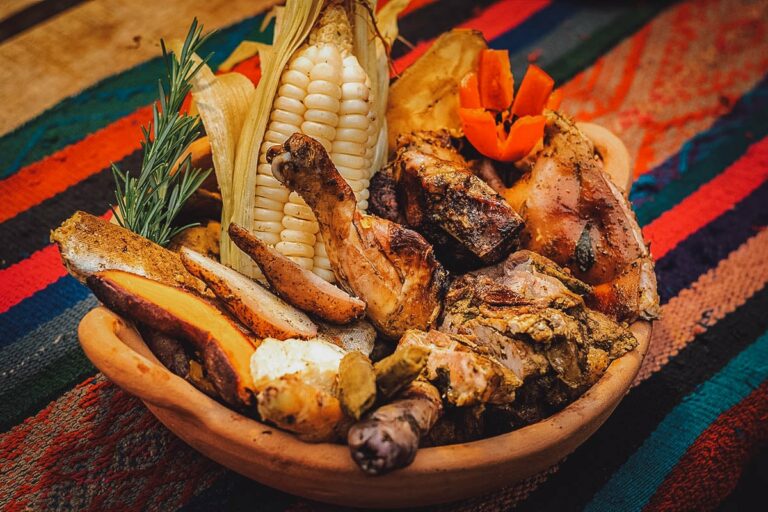Introduction: Peruvian cuisine and its global impact
Peruvian cuisine has gained popularity over the last decade, and chefs around the world are increasingly incorporating its unique flavors and ingredients into their dishes. Peru is a country with a diverse culinary culture, and its cuisine is a reflection of its rich history, geography, and ethnic diversity. Peruvian cuisine is a melting pot of culinary traditions and has been influenced by a range of cultures, including Spanish, Italian, Chinese, Japanese, and African.
Peruvian cuisine has become one of the most celebrated cuisines globally, and its impact on international culinary trends cannot be ignored. It is not only known for its exotic flavors but also its fresh and healthy ingredients, such as quinoa, maca, and purple corn. Peru’s cuisine is a fusion of various cultures and ingredients, which has made it unique and appealing to people internationally.
A brief history of Peruvian cuisine
Peruvian cuisine has a rich history that dates back to pre-Columbian times. The Incas, who were skilled farmers, raised crops such as corn, potatoes, and quinoa, which remain staples in Peruvian cuisine today. When the Spanish arrived in the 16th century, they brought with them new foodstuffs, spices, and cooking techniques that were seamlessly integrated into the local cuisine. The African slaves who were brought to Peru also added their flavors and recipes to the mix.
In the 19th century, Chinese and Japanese immigrants arrived in Peru and introduced their ingredients and cooking techniques, which were adopted into Peruvian cuisine. In the 20th century, Italian immigrants brought with them pasta and pizza, which have also become popular in Peru. Today, Peruvian cuisine is a unique blend of indigenous, Spanish, African, Asian, and Italian influences.
The unique flavors and ingredients of Peruvian cuisine
Peruvian cuisine is characterized by its unique flavors, which are achieved through the use of a variety of ingredients and spices. Some of the most popular ingredients in Peruvian cuisine include potatoes, corn, quinoa, aji amarillo (a type of chili pepper), and cilantro. Peruvian cuisine also incorporates a range of herbs, spices, and fruits that are native to the country, such as huacatay, huayro potato, and lucuma.
Peruvian cuisine is also known for its diverse range of dishes, from ceviche (raw fish marinated in lime juice) to causa (a layered potato dish filled with meat or seafood). Peruvian cuisine is also famous for its roasted meats, including anticuchos (marinated beef heart skewers) and pollo a la brasa (rotisserie chicken). Another popular Peruvian dish is lomo saltado, which is a stir-fry made with beef, onions, tomatoes, and french fries.
The rise of Peruvian restaurants around the world
Over the last decade, Peruvian restaurants have been opening up all over the world, from London to New York and beyond. The demand for Peruvian cuisine has been fueled by the rise of food tourism and a growing interest in international food culture. One of the reasons for the popularity of Peruvian cuisine is its healthy ingredients and unique flavors.
Peruvian restaurants have also been recognized by some of the most prestigious culinary awards. In 2017, Maido, a Peruvian-Japanese restaurant in Lima, was ranked seventh on the list of the World’s 50 Best Restaurants. Moreover, Peruvian cuisine has been featured in various culinary magazines, such as Bon Appétit and Food & Wine.
How Peruvian cuisine has influenced international culinary trends
Peruvian cuisine has had a significant impact on international culinary trends, particularly in the areas of fusion cuisine and healthy eating. The fusion of different culinary cultures and ingredients has become a popular trend in the international culinary scene, and Peruvian cuisine is one of the pioneers of this trend.
Peruvian cuisine has also influenced the use of unconventional ingredients in cooking, such as quinoa and chia seeds, which have become popular healthy food options worldwide. Peruvian cuisine has also inspired chefs to experiment with new flavors and techniques, such as the use of aji amarillo in sauces and marinades.
Peruvian cuisine in the future: what to expect
Peruvian cuisine is expected to continue its growth and influence on international culinary trends. The fusion of culinary cultures and ingredients is becoming increasingly popular, and Peruvian cuisine is at the forefront of this trend. Additionally, Peruvian cuisine’s emphasis on healthy ingredients and fresh produce is also expected to continue.
Peruvian chefs are also experimenting with new techniques and flavors, and there is a growing interest in the use of native Peruvian ingredients. Moreover, the rise of Peruvian restaurants around the world is expected to continue, and Peruvian cuisine is likely to become even more accessible to people around the globe.

